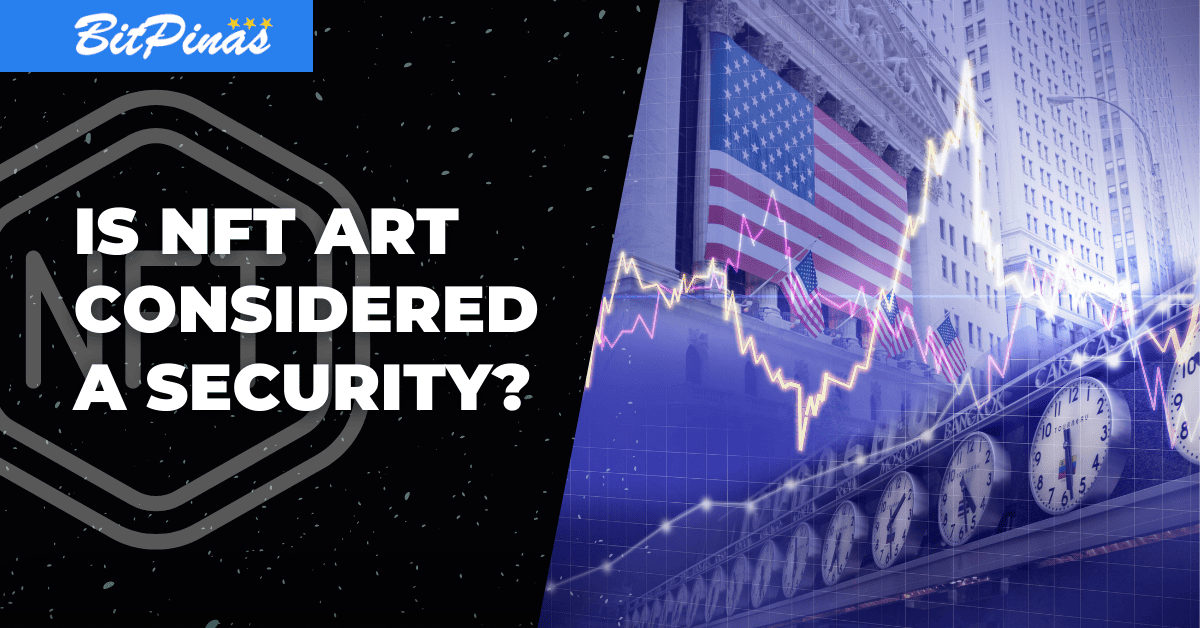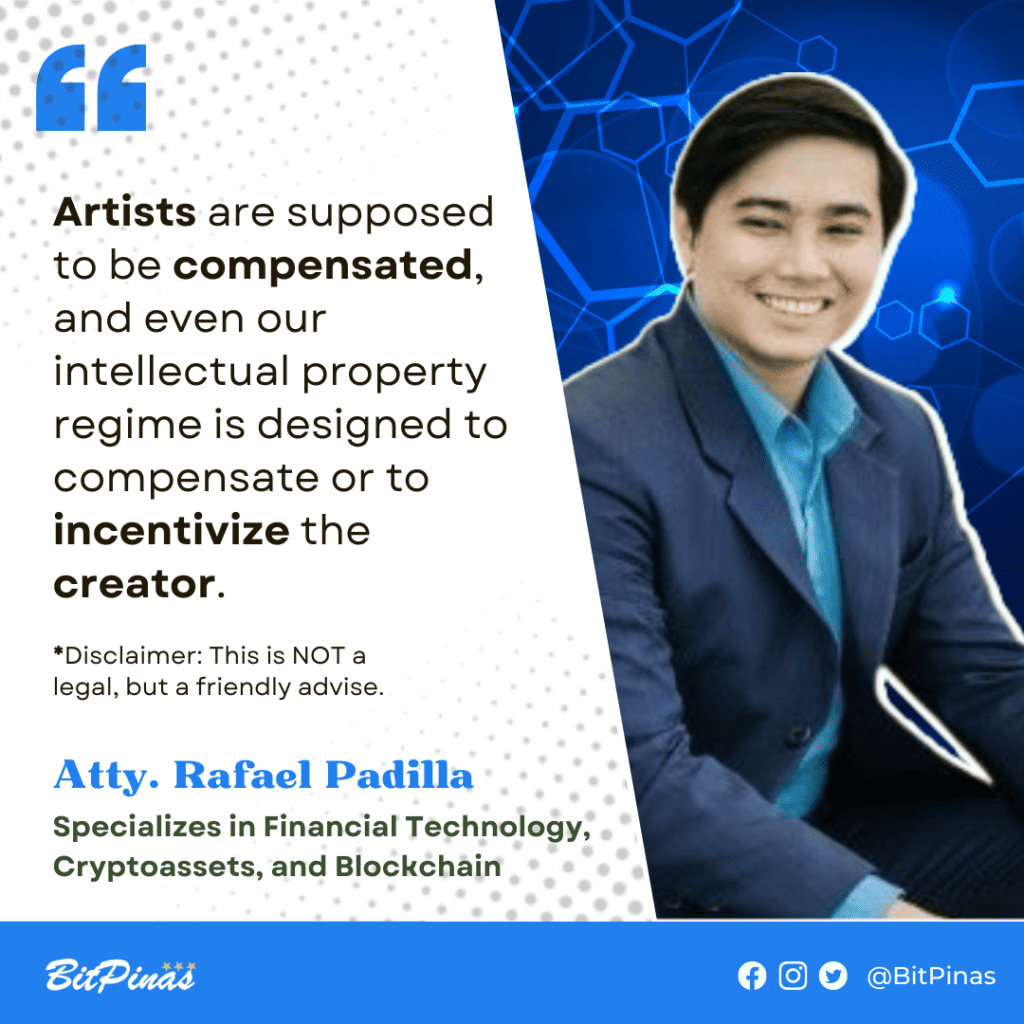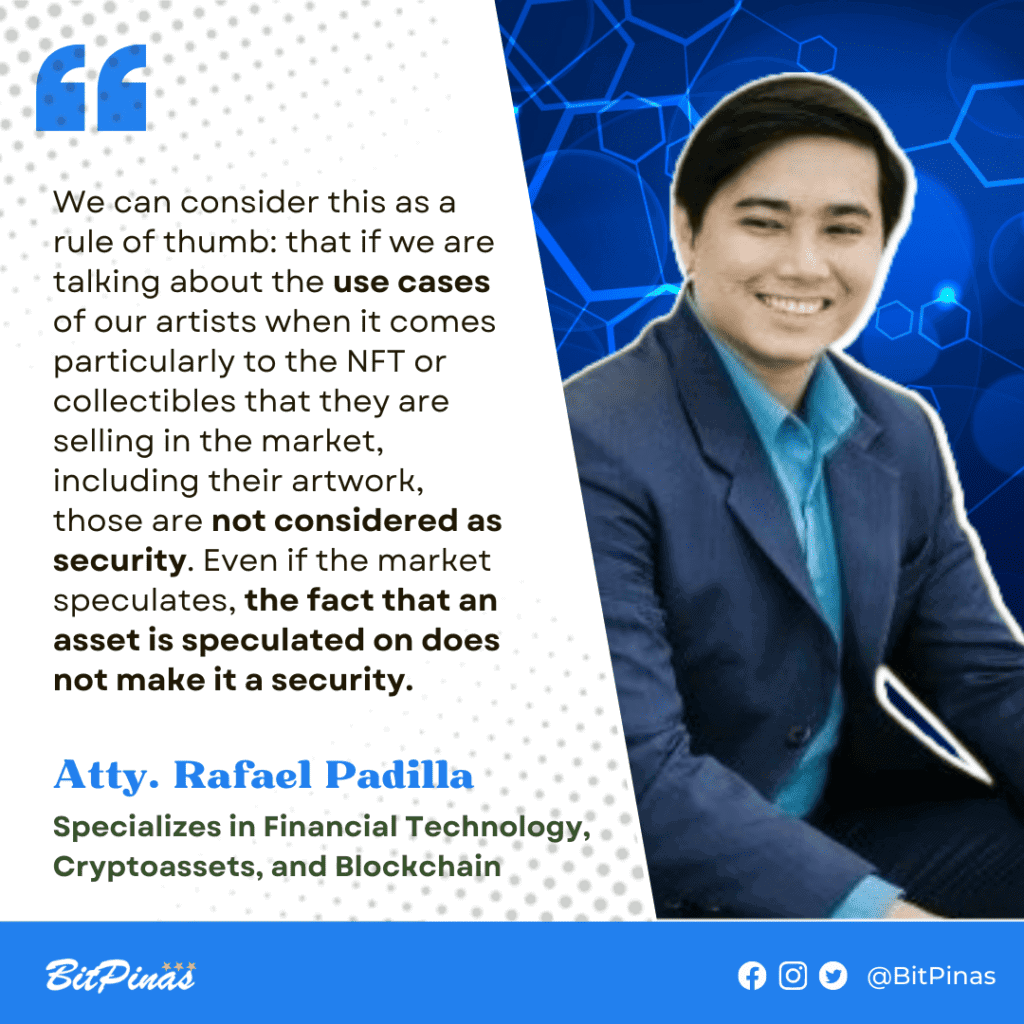Are NFT Art and Collectibles Considered Security?
Even if the market speculates, the fact that an asset is speculated on does not make it a security.

Atty. Padilla Clarifies When an NFT is a Security and When it is Not
By Nath Cajuday
“We can consider this as a rule of thumb: na if we’re talking about, lalo na sa mga artists naten, ‘yung use case nila, particularly pagdating sa NFT o sa mga collectibles na binebenta, ‘yung artwork, hindi ‘yan considered as security. Kahit pa yung market ay nag-i-speculate. The fact that an asset is speculated on does not make it a security.”
(We can consider this as a rule of thumb: that if we are talking about the use cases of our artists when it comes particularly to the NFT or collectibles that they are selling in the market, including their artwork, those are not considered as security. Even if the market speculates, the fact that an asset is speculated on does not make it a security.)
This is the clarification of Atty. Rafael Padilla, a commercial lawyer specializing in fintech and crypto, when asked about the instances that a non-fungible token (NFT) or any collectible will be considered as security during a Twitter Space hosted by BitPinas.
Please check out part 1 of this article: What is the Current State of NFT-related Laws in the Philippines?
What is Security?
According to Section 3.1 of Republic Act 8799 or “The Securities Regulation Code,” Securities are shares, participation or interests in a corporation or in a commercial enterprise or profit-making venture and evidenced by a certificate, contract, instruments, whether written or electronic in character.
In addition, the 2015 Implementing Rules and Regulations of The Securities Regulation Code, Rule 3.1.20., of the Securities and Exchange Commission (SEC), securities shall include (a) shares of stock, bonds, government securities, commercial papers, debentures, notes, evidences of indebtedness, asset-backed securities; (b) investment contracts, certificates of interest or participation in a profit sharing agreement, certificates of deposit for a future subscription; (c) fractional undivided interests in oil, gas or other mineral rights; (d) derivatives like option and warrants; (e) certificates of assignments, certificates of participation, trust certificates, voting trust certificates or similar instruments; (f) proprietary or nonproprietary membership certificates in corporations; and (g) other instruments as may in the future be determined by the Commission.
Padilla highlighted that the investment contracts mentioned in the implementing rules and regulations of SEC does not affect the artists selling their artworks.
“Kapag may isang bagay na ibinebenta at ang pangako nung nagbenta ay kikita itong mga bumibili sa kanila at binigay ‘yung pera, at kikita lamang sila dahil sa effort nitong issuer o nagbebenta ng instrumento, ‘yun ay pwedeng ma-consider na investment contract. ‘Yung mga elements na ‘yun ay hindi mo makikita in ordinary cases, sa (pagbebenta ng) mga artwork.”
(If there is an item that is for sale, and the promise of the seller is that the buyers will gain profit, if they will buy the products of the seller, and that they will only gain profit through the effort of the issuer or the seller, then that is considered as an investment contract. And those elements do not reflect in ordinary cases, such as selling artworks.)
The commercial lawyer also cited the claim of a U.S. SEC Commissioner that non-fungible items are not considered as security.
“May mga nagsasabi pa, including a Commissioner of the US Securities and Exchange Commission na kung ang ibinebenta niyo ay non-fungible, most likely ay hindi security iyan. So, kahit ibenta mo pa yan, mag-mint ka pa, non-fungible naman ‘yan.”
He stressed that this is a good thing in the community, where NFT artists can rest assured that they do not have to deal with the securities laws.
However, Padilla also clarified that this rule is not absolute, as there are still cases where NFT arts and collectibles can be considered as security.
“Ang assessment, whether something is a security, including NFT, revolves around specific facts and circumstances. So, depende sa mga facts and circumstances ‘yung NFT kung pwedeng ma-consider na security.”
(The assessment is that whether something is a security, including NFT, revolves around specific facts and circumstances. So, NFTs can be considered as security depending on the facts and circumstances it has.)
Are Fractionalized NFTs a security?
Fractionalized NFTs is the process of dividing the owner of an NFT into fractions, making it an NFT with multiple owners.
“Quick example, common na ngayon sa market ‘yung mga fractionalized NFTs para daw mabigyan ng opportunity yung mga retail investors na makabili ng NFT, maging part owner ng NFT kahit na mahal ‘yung NFT. “
(Quick example, right now, fractionalized NFTs are common in the market, to allegedly give retail investors the opportunity to buy an NFT, or be a part owner of an expensive NFT.)
Padilla, on the other hand, stated that there are instances where fractionalized NFTs can be treated as a security.
“Ang sinasabi ko lang, kailangang pag-aralan ‘yang mabuti kasi may mga mga fractionalized NFTs na pwedeng maconsider na security lalong-lalo na kung itong mga fractionalized NFTs ay dinisenyo to allow investors to speculate and invest and hopefully make some money, tapos my expectation ng profits.”
(My point is, we need to study it carefully, because there are fractionalized NFTs that can be considered as security, specially for those fractionalized NFTs that were designed to allow investors to speculate and invest and hopefully make some money, then there is an expectation of profits.)
But not all fractionalized NFTs are considered as security, the lawyer furthermore clarified that it is still a case-to-case basis.
“Pero kung ang disenyo ng fractionalized NFT natin, kaya mo siya finractionalize, para magbuo ka ng isang decentralized collective na magcu-curate ng artwork na ‘yun at finractionalize mo lang siya para magkaroon ka ng grupo na magme- maintain nung governance ng curation ng artwork na ‘yun, ‘yung ganong arrangement ay hindi security. “
(But if you designed your fractionalized NFT to create a decentralized collective to curate your artwork and you fractionalized it to form a group that will maintain the governance of the curation of your artwork, that kind of arrangement is not a security.)
Moreover, Padilla emphasized that if the purpose of the fractionalization is to decentralize the governance and not to speculate the part owners, then that is not treated as a security.

The Role of Royalty
Royalty gives legal ownership to a certain work of art or any collectible, it gives an ownership and payment for using any of the assets, including copyrighted works, franchises, and natural resources of the artist.
With this, according to Padilla, an NFT will be a security depending on where the royalty will go.
“Wala namang masamang mag-flow ang royalties doon sa content creator, sa artist. Ang problem is kapag ‘yung royalties that is supposed to be a compensation for the artwork, goes to the investors.”
(There is no problem if the royalties will go to the content creators and artists. But if the royalties that are supposed to be a compensation for the artwork, goes to the investors, that is a problem.)
He added that when the royalties will go to the investors that did not make that artwork, then that is considered as security.
“’Yun ang kailangan pag-aralan, kasi if this somehow provides investors an opportunity to passively earn income in the form of royalties, na hindi naman sila gumawa ng artwork na ‘yun, in most likelihood, pwede itong ma-consider na security.”
(That idea needs to be studied, because if it provides investors an opportunity to passively earn income in the form of royalties, that they did not even do that artwork, in most likelihood, it can be considered as security.)
Padilla emphasized that there is a need to distinguish on where the royalties go, because if the royalties exclusively go to the artists or the content creators, then the NFT is not a security.
“Artists are supposed to be compensated, and even our intellectual property regime are designed to compensate or to incentivize the creator. The pitfall here is if the royalties somehow flow through the o mapupunta sa investors kahit partial lang na royalty. Kailangang pag-aralan nang mabuti yan.”
(Artists are supposed to be compensated, and even our intellectual property regime is designed to compensate or to incentivize the creator. The pitfall here is if the royalties somehow flow through the system, or will go to investors, even if it is just a partial royalty. We need to further study it.)
The Creator and the Investor
Again, NFTs are not a security if the royalty goes to the creator or artists, but it is a security if the royalty goes to the investor.
The creator described during the space, according to Padilla, is the one who created or contributed in producing the artwork or collectibles, either a physical art that has an NFT version or a natively digital art.
But he clarified that the investors he was describing are the retail investors.
“I would classify an investor in this context as somebody who has no contribution in the actual work and who’s just buying the NFT, who is buying the NFT for purposes of possible gains if this NFT is later sold in the secondary market.”
He also explained that these are not the investors who were part to produce and finance the NFT, citing that there are companies that the business model is to mint or create NFTs made by the artists.
“Hindi ‘yun ang investor na sinasabi natin in this context. I’m more referring to retail investors who parts with their money to purchase the NFT and then with the hope of selling the NFT in the secondary market, or in the context of that royalty scheme that you’ve mentioned, hopefully to earn some royalties now from the NFT that that person purchased.”
(That is not the type of investor that we are describing in this context. I am referring more to retail investors who parts with their money to purchase the NFT and then with the hope of selling the NFT in the secondary market, or in the context of that royalty scheme that you’ve mentioned, hopefully to earn some royalties now from the NFT that that person purchased.)
The lawyer furthermore explained that these retail investors who entered this type of investments, where they are earning that royalty as a passive investment, will be viewed as an investment contract.

What should artists do so that their NFTs will not be tagged as security?
Padilla reminded the artists that whenever they make their NFTs, collectibles, or even fractionalized NFTs, promote it as a collection and not as an investment.
“Kung magfa-fractionalize ka ng NFT, o kahit ano pa in relation sa NFT o project na binebenta niyo, dapat binebenta niyo siya sa mga buyers for purposes of collection, o ‘di kaya, for consumption at hindi niyo siya binebenta bilang investment.”
(If you will release a fractionalized NFT, or any item or project related to NFT that you will market, sell it to your buyers for purposes of collection or for consumption. Do not sell them as an investment.)
He stressed that the market has a different way of treating assets, and if the market wants to speculate on it, we cannot stop it.
“Pero ang pwede nating gawin is to be diligent and to be vigilant, and we don’t add fuel to the fire, na alam naman na natin na speculative na ‘yung asset, para lang mabenta ‘yung NFT natin, pino-promote pa natin as an investment,” Padilla concluded.
(But the only thing that we can do is to be diligent and be vigilant, and we should not add fuel to the fire, that if we know that the asset is speculative, we will promote it as an investment that is able to be sold.)
This article is published on BitPinas: Are NFT Art and Collectibles Considered Security?
Everything in this article must not be construed as legal advice.





